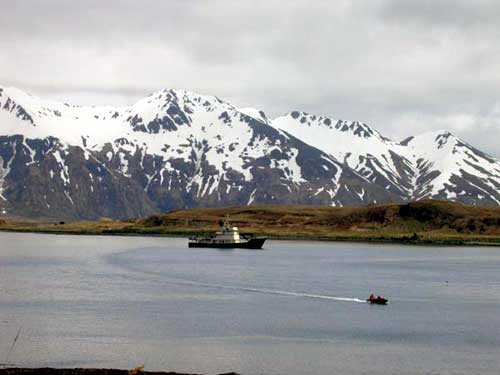 by Ned Rozell June 17, 2004
A few days ago, we were building a small shelter cabin for biologists on Buldir Island where they are studying the millions of seabirds that nest on that relative speck in a giant ocean. The day before that, we counted nests of the once-endangered Aleutian Canada goose on Nizki island.  Photo by Ned Rozell
During the next three weeks, my columns will reflect the studies I have observed as a guest of Steve Ebbert, a wildlife biologist for the refuge, which is part of the U.S. Department of Fish and Wildlife. Steve had answers for almost all of my questions, even about World War II relics rusting in place on the islands of Kiska and Attu. Nothing is rusting in place on this ship. Today, for example, we sailed to Kasatochi Island to pick up two women biologists there, and then whisked them to Ulak, where they are now on the hillside doing the storm-petrel survey with refuge biologist Jeff Williams and Oregon State University ecologist Dan Roby. The study is a part of a refuge plan to get numbers of all the important species of birds that nest in the Aleutians, so they can tell if future populations take a nosedive, remain stable, or increase. The ship won't return for good to Homer until September 13. By then, its crew will have supported scientists studying sea otters, many species of birds, sea lions, rats, and also trappers trying to get foxes off several islands. After the biologists on Ulak return by inflatable boat, the captain will reel in the anchor and take them back to Kasatochi. We will then head to Adak in the center of the Aleutian chain, where several of us will catch an airplane east to Anchorage. The past three weeks have given me a new appreciation for how difficult it is to get here, how bad Alaska weather can be, and the richness of the Aleutians. We once anchored near a lava dome on the north side of Kiska island that is home to an estimated 3-to-6 million auklets that swirled overhead like pepper sprinkled in the breeze. For all the islands we have visited during my time aboard, we have seen people on only two, Shemya, which hosts part of a missile-defense system, and Attu, home to a Coast Guard Loran station. The remaining islands we saw are the home of birds, some rats, a few foxes, and constant winds that tangle the knee-high grasses. Watch this space during the next three weeks for stories on rats versus auklets on Kiska, the transplant of a rare ptarmigan from island to island, and the impressive comeback of the Aleutian Canada goose. I hear the anchor chain clanking
now. Signing off from the Tiglax, where the Bering Sea meets
the north Pacific. This column is provided as
a public service by the Geophysical Institute, University of
Alaska Fairbanks, in cooperation with the UAF research community.
Ned Rozell is a science
writer at the institute.
|